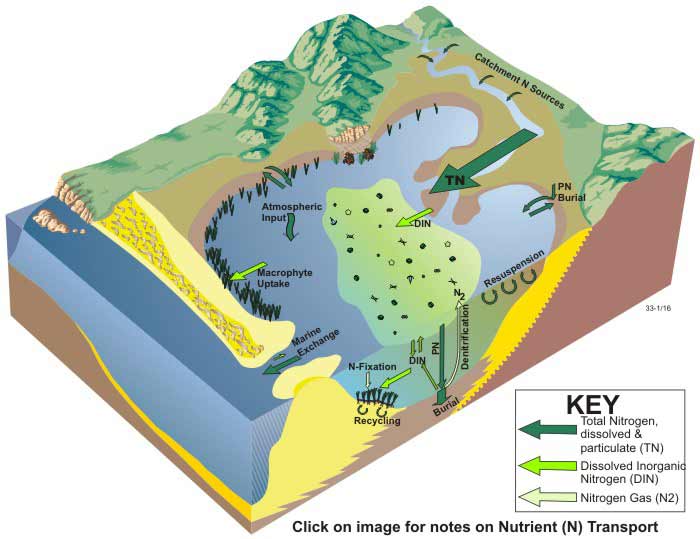
Nitrogen dynamic processes in wave-dominated estuaries
1. Point and non-point nitrogen sources
Nitrogen, both particulate and dissolved or total nitrogen, enters the estuarine system from point- and non-point sources from within the catchment. River flow and nutrient input varies regionally, depending on local catchment and climatic conditions. However, the input of catchment-derived nutrients into estuaries and deltas is typically high (Harris, 2001).
2. Atmospheric input
Input of particulate nitrogen from atmospheric sources such as smoke and ash is significant in some wave-dominated estuaries.
3. Processing of nitrogen by phytoplankton
The dissolved inorganic nitrogen is transported into the central basin of the estuary, with biological uptake by phytoplankton (Gaughan et al., 1995, Webster et al., 1998), seagrasses, benthic micro- and macroalgae (Webster et al., 2002), and macrophytes occurring along the way, if residence times are long enough, and if temperature, turbidity, and light levels are suitable. The balance between planktonic and benthic primary productivity may depend on catchment nitrogen loads (Eyre et al., 2002).
4. Burial and resuspension in intertidal flats
Some deposition and burial of particulate nitrogen occurs on flanking environments, due to the baffling effect of saltmarsh and/or mangrove, where present, vegetation (Boon et al., 1988, Nedwell et al., 1988, Howes et al., 1994, Laegdsgaard, 2001). Burial and resuspension of particulate nitrogen and dissolved inorganic nitrogen can also occur within intertidal flats (Alongi et al., 1999). Some PN may be deposited and buried within the fluvial delta.
5. Phytoplankton debris
PN is deposited in the sediment as phytoplankton debris.
6. Denitrification and venting of N2 gas
Decomposition of organic matter within the sediment produces dissolved inorganic nitrogen, potentially available for further plant/phytoplankton growth. Denitrification within the sediment converts nitrate (NO32-) to N2 gas, which escapes from the system to the atmosphere (Heggie et al., 1999a). Some of the particulate nitrogen deposited into the sediment of the central basin is buried.
7. Uptake of nitrogen by seagrasses
Seagrasses take up dissolved inorganic nitrogen from the water column, and from the sediment pore-waters (Bulthuis et al., 1984, Bulthuis et al., 1992). The pore-water dissolved inorganic nitrogen is derived from the metabolism of phytoplankton, seagrass and other organic matter debris. The seagrass debris therefore, in part, is ?recycled? back to the plants. Nitrogen-fixation (incorporation of atmospheric N2 to form nitrogenous organic compounds) occurring in the root-zone contributes additional dissolved inorganic nitrogen to this pool (Moriarty et al., 1985, Smith, 1990). Denitrification is also an important process in seagrass meadows. Sandy sediment is permeable, hence can be ventilated by oxygen-rich overlying waters resulting in efficient remineralisation of organic debris, mostly by denitrification, with little preservation of organic matter.
8. Small export of nitrogen to the marine environment
Due to the long residence time typical of wave-dominated estuaries, most catchment-derived nitrogen is processed and effectively trapped by the estuary. Typically, only very small quantities of the total nitrogen load are exported to the marine environment, however export is much larger during significant during flood events (Nixon et al., 1996).


